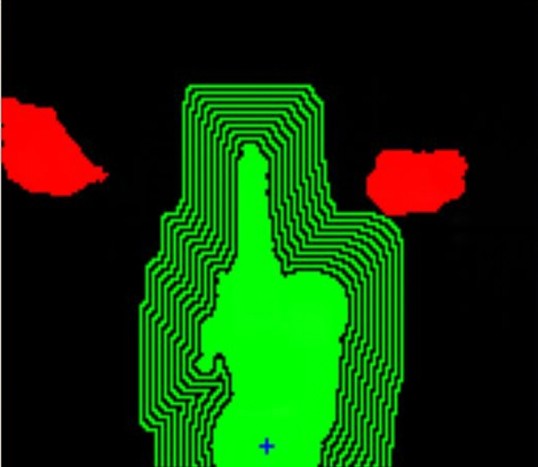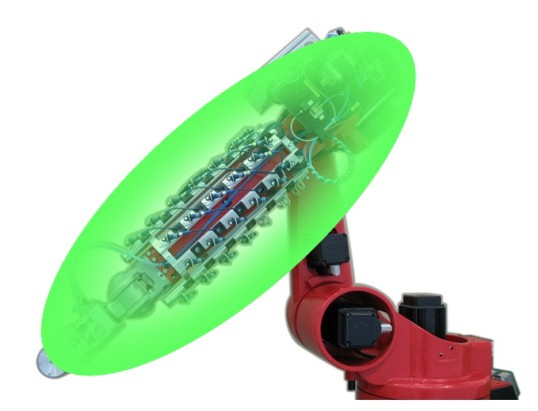- Artificial Intelligence (AI)
- Occupational exposure limit values
- List of CMR substances
- Ergonomics
- EU GHS Regulation
- Industrial Security
- Collaborative robots
- Noise
- Nanoparticles at the workplace
- NoRA OSH standards search tool
- REACH
- Reference materials
- Proficiency testing
- Radiation
- Vibration
- Virtual reality
- Work 4.0
Technical protective measures
Safe control systems are an essential element at a workplace involving collaborative robots. These systems are able to monitor all movements of the robot and to stop it immediately should it move with excessive velocity or to an inadmissible position. This requires the robot control to be able to detect, by means of safe sensors such as cameras or tactile sensors, where the operator is moving. The robot then does not approach the operator too closely, or avoids him or her. This enables workplaces to be created at which human operators are supported by robots. Despite these technical protective measures, a minor risk of collision remains.
At the IFA, suitable new technologies for protective measures are tested on collaborative robots and evaluated, for example during research projects and students' degree theses:
- A pilot implementation of a dynamic safety zone for robots was achieved with the aid of a non-safe Photonic Mixer Device (PMD) 3D camera. For each camera pixel, this implementation determines the distance between the camera and the observed objects, up to a distance of 7.5 m. This enables several persons to be detected and tracked.
- A further project studied a solution involving ultrasonic sensors. These have already proved effective in safety engineering. They have the advantage of reacting to any approach within the detection area and always signalling the result of measurement in the form of the shortest distance to the detected object. The processing overhead for each sensor is low, thereby enabling a larger number of sensors to be employed, guaranteeing seamless coverage.
- In the EsIMiP project funded by the Bavarian Research Foundation (AZ 852 08), a concept was developed in which the robot is "clothed" with outward-facing ultrasonic sensors. The concept resembles that of parking sensor systems used in cars in which a small number of ultrasonic sensors are integrated into the car's bumper, although the number of sensors used on the robot is greater. The video about the project EsIMiP can be found on the homepage of the Technical University Munich. One project part, handled by the IFA, is presented in the video 'Teil 3'.
- A 3D camera system enables the entire working space to be covered and can therefore be used for the planning of evasive movements. At the same time, these movements can be monitored by the ultrasonic sensors for dangerous approach movements. Once the ultrasonic sensors have detected an approach movement, downstream algorithms reduce the velocity of the robot. This enables non-safety related, experimental algorithms to be used in the camera technology and path planning; the operator remains safeguarded by the safety system consisting of ultrasonic sensors.
Besides the research topics described, the IFA conducts studies into the safety of camera systems and tests/certifies their safety, and is also involved in ongoing standardization activity (IEC 61496-4).
For downloading

- Entwicklung eines Konzepts zur sicheren Personenerfassung als Schutzeinrichtung an kollaborierenden Robotern, Doctorate, Björn Ostermann
- Industrial jointed arm robot evading dynamic objects,
Master thesis (PDF, 1.7 MB, non-accessible) , Björn Ostermann - Ostermann, B. et al..: Von Zäunen befreit - Industrieroboter mit Ultraschall absichern (PDF, 1.2 MB, non-accessible) . atp edition – Automatisierungstechnische Praxis (2011) No. 9, pp. 888-895
- Stengel, D. et al..: An Approach for Safe and Efficient Human-Robot Collaboration (PDF, 120 kB, non-accessible) . 6th International Conference on Safety of Industrial Automated Systems – SIAS 2010, 14.-15 June 2010, Tampere/Finnland (paper). Conference proceedings. Published by.: Finnish Society of Automation, Helsinki, Finnland 2010
Order reprint - Heinke, B.; Bömer, T.: Sehende Überwachungen (PDF, 1.8 MB, non-accessible) . TÜ 50 (2009) No. 10, pp. 21-25
- Start Video: Operation of the dynamic safety zone (MP4, 6 MB)


